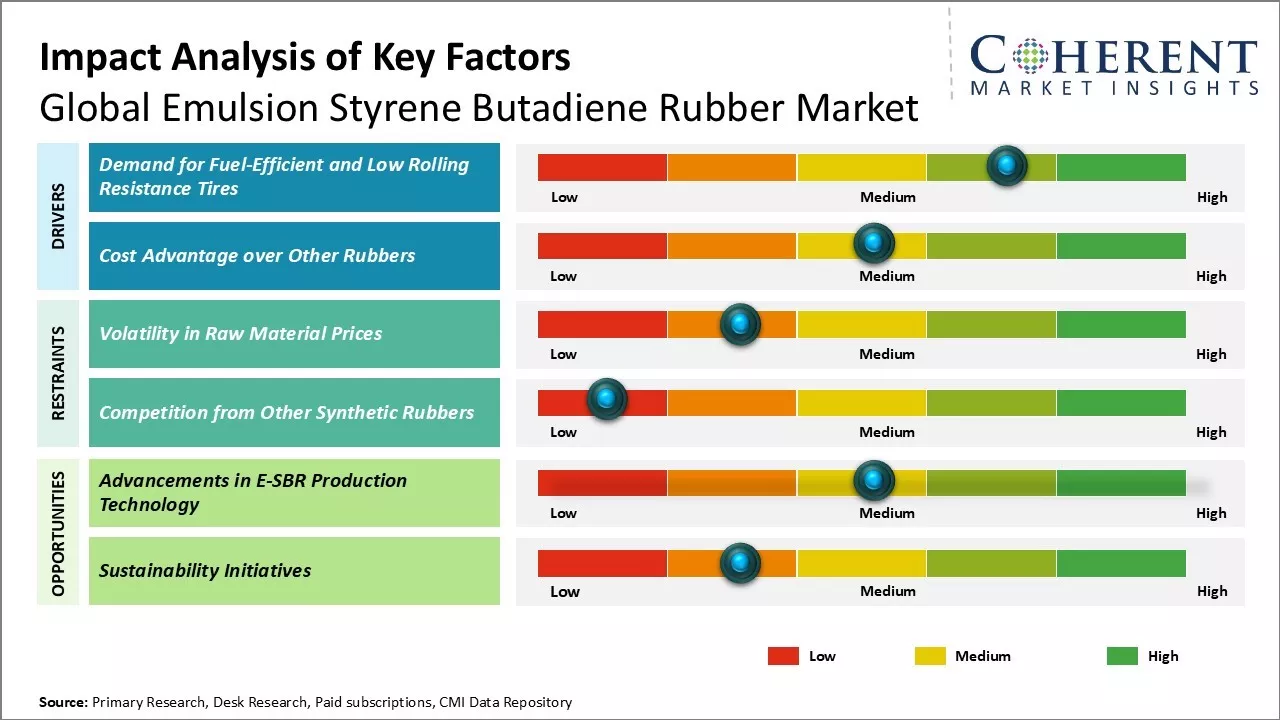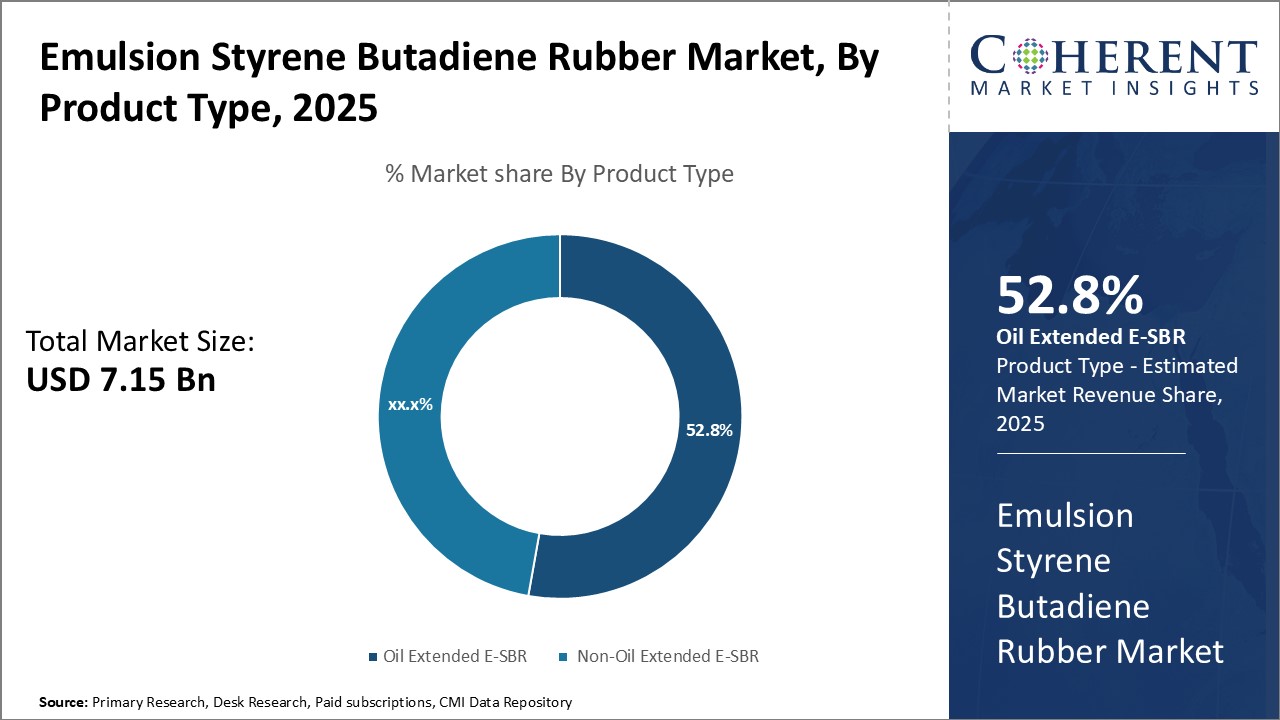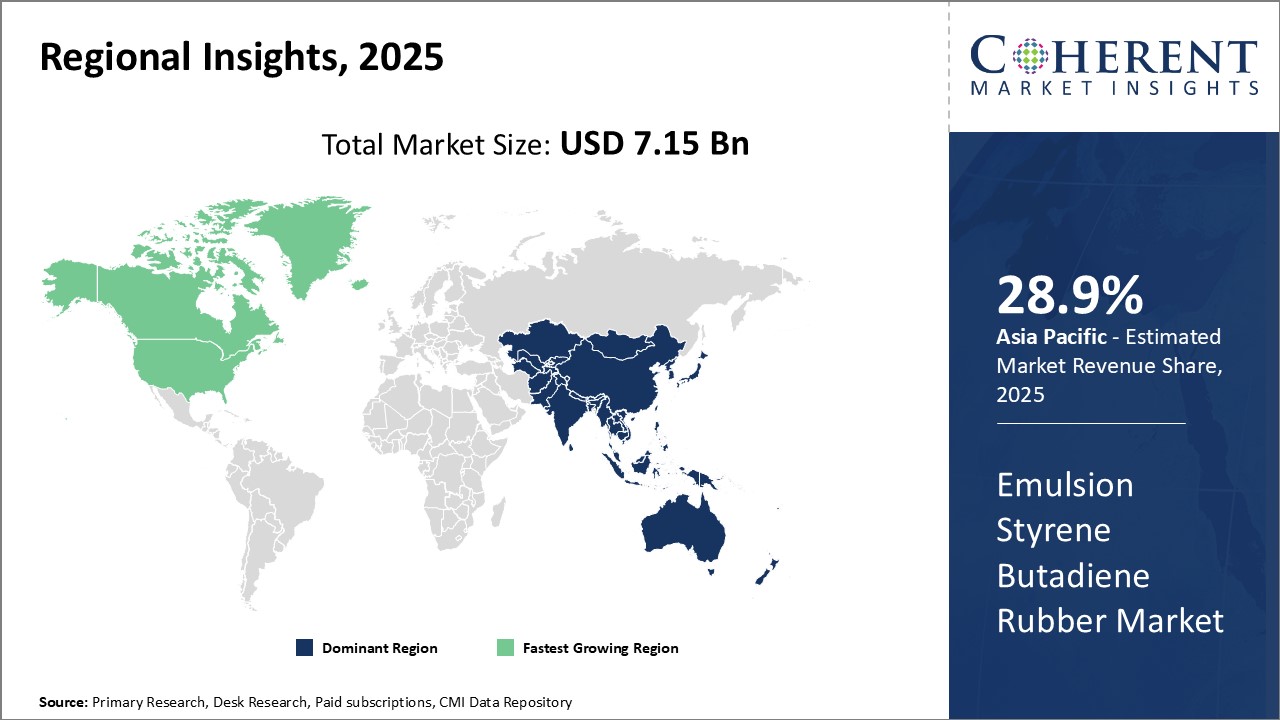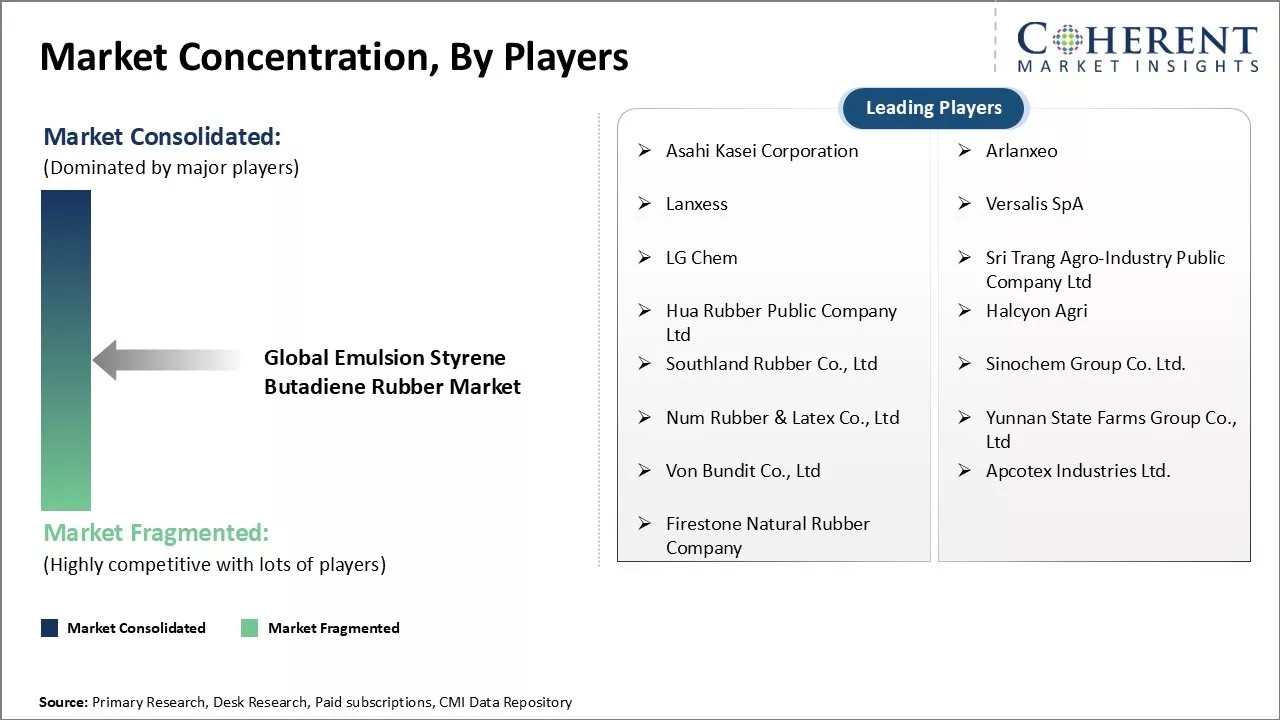The global emulsion styrene butadiene rubber market is estimated to be valued at USD 7.15 Bn in 2025. It is expected to reach USD 9.93 Bn by 2032, exhibiting a CAGR of 4.8% from 2025 to 2032.

Discover market dynamics shaping the industry: Download Free Sample
The market is anticipated to witness steady growth over the forecast period owing to increasing application of emulsion styrene butadiene rubber (E-SBR) in industries such as automotive, footwear, and polymer modification. The demand for emulsion styrene butadiene rubber is expected to increase in the coming years due to increasing applications in the automotive and footwear industries. Replacement of natural rubber and superior properties of ESBR over natural rubber is further expected to support the market growth during the forecast period.

Discover high revenue pocket segments and roadmap to it: Download Free Sample
Insights By Product Type - Oil Extended E-SBR segment dominates due to fuel efficiency
In terms of product type, oil extended E-SBR segment is estimated to contribute the highest market share of 52.8% in 2025, owing to its superior properties that enhance fuel efficiency in vehicles. Oil extended E-SBR contains 30-40% oil content that makes the tires incorporating this material more durable and provides longer wear life.
Insights By Application – Tires & Tire Products dominate E-SBR consumption
In terms of application, tires & tire products segment is estimated to contribute the highest market share of 24.8% of the emulsion styrene butadiene rubber market in 2025. Over 70% of E-SBR is used in tire components like treads and sidewalls, due to its excellent abrasion resistance. E-SBR creates a resilient matrix that maintains tire integrity under the stress and friction of heavy-duty conditions.
Insights By Manufacturing Process - Cold emulsion SBR (Cold E-SBR) segment leads due to its advantages
In terms of manufacturing process, cold emulsion SBR (Cold E-SBR) segment is estimated to contribute the highest market share of 51.6 % in 2025. This process uses direct emulsion polymerization of monomers without heat, enabling efficient continuous manufacturing and enhancing mass production capabilities, ultimately improving the overall efficiency of emulsion styrene butadiene rubber production.

Need a Different Region or Segment? Download Free Sample
Regional Analysis: Global Emulsion Styrene Butadiene Rubber Market
Dominating Region: Asia Pacific
Asia Pacific is expected to dominate the overall market in 2025 with an estimated share of 28.9%. The region's industry-friendly policies and availability of raw materials at competitive prices have helped local as well as global players establish production hubs.
Fastest-Growing Region: North America
North America region exhibits the fastest growth, led by improving economic conditions in key markets like the U.S. and Canada. Growth initiatives by governments focused on upgrading public infrastructure have augmented North America’s consumption of emulsion styrene butadiene rubber in applications ranging from footwear to housing.
Emulsion Styrene Butadiene Rubber Market Outlook for Key Countries
China’s Leading Position in Tire Production and Consumption
China is one of the largest markets for E-SBR globally due to its position as the largest producer and consumer of tires. The automotive sector in China, especially the electric vehicle (EV) market, continues to grow, bolstering the demand for E-SBR.
Robust Automotive and Construction Industry and the Rise of EVs Drive E-SBR Adoption in the U.S.
The U.S. is one of the largest consumers of E-SBR, with demand largely driven by its robust automotive and construction sectors. Major tire manufacturers such as Goodyear and Bridgestone have a strong presence, fueling E-SBR demand for tire production. Additionally, the increasing shift toward electric vehicles (EVs) and infrastructure investments are further boosting the market, as E-SBR is crucial for high-performance and energy-efficient tires.
Automotive Growth and Infrastructure Investments Fueling Demand in India
India is a growing market for E-SBR, driven by a rapidly expanding automotive sector, especially in the two-wheeler and passenger vehicle segments. The country is also investing heavily in infrastructure, which boosts demand for rubber in the construction sector.
High Demand from Automotive and Construction Industries in Canada
Canada’s emulsion styrene butadiene rubber market, though smaller than the U.S., is projected to grow steadily, fueled by demand from its automotive and construction industries. With automotive manufacturing hubs in Ontario, Canada plays a key role in supplying vehicles for North American markets. Additionally, the country's focus on infrastructure development and sustainable practices in rubber products, including eco-friendly tires, supports moderate growth in the E-SBR sector.

Get actionable strategies to beat competition: Download Free Sample
Top Strategies Followed by Global Emulsion Styrene Butadiene Rubber Market Players
Emerging Startups in the Global Emulsion Styrene Butadiene Rubber Market
Innovative Technologies: Several startups are creating advanced sensor formulations and smart rubber materials. One example is SyncTech Rubber, which has developed an emulsion SBR composite containing graphene nano-platelets. This enables real-time monitoring of tyre pressure and temperature. Such innovations could transform preventive fleet management and auto manufacturing.
Sustainable Solutions: Emerging companies are also focusing on more eco-friendly emulsions. CaliRub, a California-based startup, produces sustainable styrene butadiene rubber using vegetable oil and bio-based styrene. Their products have a much lower carbon footprint compared to petroleum-based SBR. Adoption of such green alternatives may help the industry meet sustainability targets. Market Contribution: Startups play a vital role in addressing specialty needs. Rubbot Inc. specializes in very small-batch Orders of custom non-black rubber goods for medical devices.
Key Takeaways from Analyst
Emulsion Styrene Butadiene Rubber Market Report Coverage
| Report Coverage | Details | ||
|---|---|---|---|
| Base Year: | 2024 | Market Size in 2025: | USD 7.15 Bn |
| Historical Data for: | 2020 To 2024 | Forecast Period: | 2025 To 2032 |
| Forecast Period 2025 to 2032 CAGR: | 4.8% | 2032 Value Projection: | USD 9.93 Bn |
| Geographies covered: |
|
||
| Segments covered: |
|
||
| Companies covered: |
Asahi Kasei Corporation, Arlanxeo, Lanxess, Versalis SpA, LG Chem, Sri Trang Agro-Industry Public Company Ltd, Hua Rubber Public Company Ltd, Halcyon Agri, Southland Rubber Co., Ltd, Sinochem Group Co. Ltd., Num Rubber & Latex Co., Ltd, Yunnan State Farms Group Co., Ltd, Von Bundit Co., Ltd, Apcotex Industries Ltd., and Firestone Natural Rubber Company |
||
| Growth Drivers: |
|
||
| Restraints & Challenges: |
|
||
Uncover macros and micros vetted on 75+ parameters: Get instant access to report
Market Driver - Demand for Fuel-Efficient and Low Rolling Resistance Tires
As the transportation sector faces pressure to enhance fuel efficiency and cut emissions, the demand for advanced tires is rising. Emulsion styrene butadiene rubber is crucial for manufacturers to create low rolling resistance tires, enabling vehicles to achieve better mileage. March 2021, according to the International Energy Agency, the transport sector was responsible for 24% of global energy-related CO2 emissions in 2020, with road transport being the largest contributor.
Market Challenge - Volatility in Raw Material Prices
A key challenge for the global emulsion styrene butadiene rubber market is the volatility of raw material prices, as ESBR is derived from petroleum-based materials like styrene and butadiene. According to the U.S. Energy Information Administration, in 2023, crude oil prices fluctuated sharply, rising from about US$ 60 per barrel in December 2020 to over US$ 120 in March 2022 due to supply issues and geopolitical tensions, affecting production costs for ESBR manufacturers.
Market Opportunity - Advancements in E-SBR Production Technology
The global emulsion styrene butadiene rubber market is presented with significant opportunities due to advancements in production technology. Innovations in emulsion polymerization have enabled manufacturers to customize E-SBR grades to meet specific customer needs. The adoption of mini-emulsion polymerization, which uses nanosized monomer droplets, enhances reactions by increasing the surface-to-volume ratio, facilitating faster and more controlled polymerization, according to a 2022 European Commission report on nanotechnology.
Share
Share
About Author
Yash Doshi is a Senior Management Consultant. He has 12+ years of experience in conducting research and handling consulting projects across verticals in APAC, EMEA, and the Americas.
He brings strong acumen in helping chemical companies navigate complex challenges and identify growth opportunities. He has deep expertise across the chemicals value chain, including commodity, specialty and fine chemicals, plastics and polymers, and petrochemicals. Yash is a sought-after speaker at industry conferences and contributes to various publications on topics related commodity, specialty and fine chemicals, plastics and polymers, and petrochemicals.
Missing comfort of reading report in your local language? Find your preferred language :
Transform your Strategy with Exclusive Trending Reports :
Frequently Asked Questions
Joining thousands of companies around the world committed to making the Excellent Business Solutions.
View All Our Clients